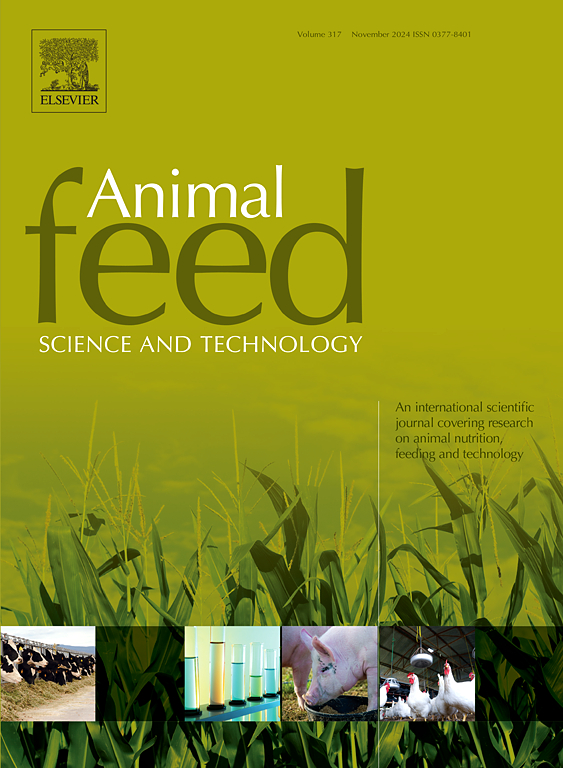In ovo maltodextrin feeding and breeder age: Effects on hatchability, hatching weight, serum glucose, glycogen reserves, organ development and intestinal histomorphology in ducklings
IF 2.7
2区 农林科学
Q1 AGRICULTURE, DAIRY & ANIMAL SCIENCE
引用次数: 0
Abstract
This study investigates the effects of in ovo maltodextrin feeding level and breeder age on hatchability, hatching weight, serum glucose levels, glycogen reserves, development of internal organs, and intestinal histomorphology of ducklings of the White Mallard breed. A total of 720 eggs, from 34-to-42-weeks-old breeders (early to late laying periods), were incubated, of which 80 eggs were selected each week and on the 23rd day of incubation were subjected to in ovo injection with maltodextrin at one of four levels: 0 %, 1.5 %, 3 %, or 4.5 %. The interaction between breeder age and maltodextrin level affected hatching weight significantly, where values were highest in ducklings from 41- and 42-week-old breeders injected with 1.5 % and 3.0 % maltodextrin, respectively. The hatchability decreased to 4.5 % maltodextrin. Ducklings from older breeders had higher serum glucose levels, with glycogen reserves not significantly affected. The weight percentage of the gizzard was positively influenced by the 1.5 % maltodextrin administered to breeders 39 weeks old. The cecum percentage showed a linear increase as maltodextrin levels increased. The breeder age significantly affected organ and gut parameters, with older breeders producing ducklings with lower organ percentages and shorter duodenum lengths. Intestinal histomorphology depended on both factors: 1.5 % maltodextrin (for breeders aged 39 weeks old) and 3.0 % maltodextrin (for breeders aged 42 weeks old) increased the height and surface area of villi in the ileum. Villus height-to-crypt depth ratio decreased by 4.5 % maltodextrin with 42-week-old breeder ducklings.
蛋蛋麦芽糖糊精饲喂和种龄对雏鸭孵化率、孵化重、血清葡萄糖、糖原储备、器官发育和肠道组织形态的影响
本试验研究了蛋清麦芽糖糊精饲喂水平和种龄对白绿头鸭雏鸭孵化率、孵化重、血清葡萄糖水平、糖原储备、内脏器官发育和肠道组织形态学的影响。试验共孵育34 ~ 42周龄种鸡(产蛋前期至后期)720只蛋,每周选取80只蛋,于孵育第23天在蛋内注射0 %、1.5 %、3 %、4.5 % 4种水平的麦芽糊精。雏鸭年龄与麦芽糊精水平的交互作用显著影响雏鸭的孵化体重,41周龄和42周龄分别注射1.5 %和3.0 %麦芽糊精的雏鸭孵化体重最高。麦芽糖糊精的孵化率降至4.5 %。年龄较大的雏鸭血清葡萄糖水平较高,糖原储备没有明显影响。饲粮中添加1.5 %麦芽糖糊精对39周龄种鸡沙囊重率有正向影响。盲肠百分率随麦芽糊精水平的增加呈线性增加。年龄对器官和肠道参数有显著影响,年龄越大的雏鸭器官比例越低,十二指肠长度越短。肠道组织形态学取决于这两个因素:1.5 %麦芽糊精(39周龄)和3.0 %麦芽糊精(42周龄)增加了回肠绒毛的高度和表面积。麦芽糖糊精使42周龄种鸭绒毛高度与隐窝深度比降低了4.5 %。
本文章由计算机程序翻译,如有差异,请以英文原文为准。
求助全文
约1分钟内获得全文
求助全文
来源期刊

Animal Feed Science and Technology
农林科学-奶制品与动物科学
CiteScore
6.00
自引率
6.20%
发文量
266
审稿时长
3 months
期刊介绍:
Animal Feed Science and Technology is a unique journal publishing scientific papers of international interest focusing on animal feeds and their feeding.
Papers describing research on feed for ruminants and non-ruminants, including poultry, horses, companion animals and aquatic animals, are welcome.
The journal covers the following areas:
Nutritive value of feeds (e.g., assessment, improvement)
Methods of conserving and processing feeds that affect their nutritional value
Agronomic and climatic factors influencing the nutritive value of feeds
Utilization of feeds and the improvement of such
Metabolic, production, reproduction and health responses, as well as potential environmental impacts, of diet inputs and feed technologies (e.g., feeds, feed additives, feed components, mycotoxins)
Mathematical models relating directly to animal-feed interactions
Analytical and experimental methods for feed evaluation
Environmental impacts of feed technologies in animal production.
 求助内容:
求助内容: 应助结果提醒方式:
应助结果提醒方式:


